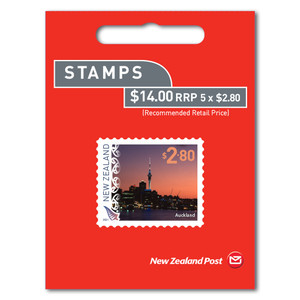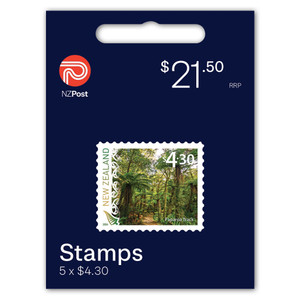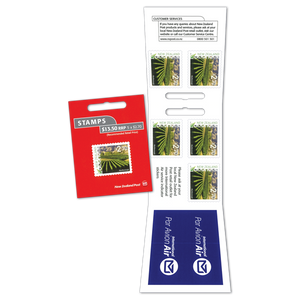This issue of 1996 Self-adhesive Scenic Definitive stamps were released in May 1996 in dispenser boxes containing coils of 100 stamps. The issue consisted of six different stamp designs, all with a 40c denomination, repeated on each coil.
Issue information
The stamps were originally produced by Australia Post-Sprintpak, utilising new dot screen technology which provided finer detail and greater clarity in the reproduction of the stamps. These stamps were among the first in the world to be produced using this particular technology.
The six scenes represented some of New Zealand’s most treasured natural scenery.
In January 1998 these stamps were produced in a booklet of ten format by Southern Colour Print, New Zealand. During the initial print run a quantity of the 40c Tory Channel stamp was printed with the text 'Marlborough Sounds' missing.
Four versions of this booklet were available; each with a different advertising panel. The series started with a booklet advertising the Reader's Digest Motoring Guide to New Zealand and went on to include advertisements for the Scenic Skies presentation pack, Town Icons presentation pack and the Rugby Super 12 team packs.
In 2000 Southern Colour Print produced the stamps in a coil format.
Product Listing for 1996 Self-adhesive Scenic Definitives
Click on image to enlarge.
| Image | Title | Description | Price |
|---|---|---|---|
 |
Set of Stamps |
Mint, used or cancelled 6 x 40c self-adhesive strip of stamps. The individual stamps in this issue were: Piercy Island, Bay of Islands Located at the eastern entrance to the Bay of Islands on the north-east coast of the North Island, Piercy Island is noted for one thing. This squib of an island, rocky and barren, has a natural hole right through it at sea level. Of course it is known to everyone as the "Hole in the Rock". Launches and other small boats can pass through easily when the sea is calm and Piercy Island has become a "must see" on Bay of Islands cruises. The island is another feature on the New Zealand coast named by Captain Cook. He bestowed the name in honour of one of the Lords of the Admiralty. Mount Egmont/Taranaki Majestic Mount Egmont stands alone, rising starkly from the flat land on the central west coast of the North Island. Māori legend has it that the peak was banished to its present location after a quarrel with the big volcanoes to the east in the central North Island. The mountain has a beautiful symmetric cone and reaches 2518 metres. Scientists think it last erupted about 1755AD and because of this it is considered dormant rather than extinct. Egmont was named in 1770 by explorer James Cook as he sailed past, but the Māori name Taranaki (Barren Mountain) was given equal and official status in 1986. Fox Glacier This great 14 kilometre long glacier and its nearby companion, Franz Josef Glacier, plunge from the high alpine snow fields in the Southern Alps to their terminal faces only a few hundred metres above sea level. What makes both so popular is that they are so accessible from the main west coast highway. Almost nowhere else in the world can sightseers get face-to-face with a glacier so quickly and easily. Fox and Franz Josef have made spectacular progress toward the sea in the past three years, both growing at an average rate of 50cm a day. Fox Glacier was named after William Fox, Premier (Prime Minister) of New Zealand on four occasions last century. Lake Matheson One of the jewels in the New Zealand tourist crown, Lake Matheson is best known for its marvellous reflected views of Mount Cook and Mount Tasman. On windless days the still waters of this small South Island lake reproduce stunning mirror images of the snow-laden peaks. The scene is so evocative of peace and tranquillity it was chosen as the subject for one of the Peace issue stamps after World War II. Lake Wakatipu At almost 300 square kilometres in area, Lake Wakatipu is the second largest South Island lake; exceeded only by Te Anau. Zig zag in shape, Wakatipu was dug out by glacial action in a past ice age. It is surrounded by mountains and the area is crammed with historical and scenic attractions. Queenstown, the tourist capital of the South Island, nestles on the lakeside where the middle and southern arms join. Tucked away in the left foreground of this stamp is the veteran steamer Earnslaw which has been carrying tourists on the lake for many years. Tory Channel, Malborough Sounds Tory Channel is familiar to generations of New Zealanders who have crossed the Cook Strait between the North and South Islands. Steamers and ferries heading south from Wellington for the railhead terminal at Picton have always used Tory Channel because the narrow, twisting passage provides a nice shortcut. Generations of passengers have welcomed their arrival in the channel for its waters are always calm - in marked contrast to the often storm-tossed Cook Strait. Tory Channel is part of the complicated network of waterways making up the Marlborough Sounds and was named after the survey ship Tory which navigated its tricky path in 1839. |
$2.40 |
 |
First Day Cover | First day cover with six self-adhesive stamps affixed. Cancelled on the first day of issue. | $2.65 |
 |
Self-adhesive Dispenser | Dispenser box containing 100 x 40c self-adhesive stamps. | $40.00 |

Technical information
| Date of issue: | 1 May 1996 |
|---|---|
| Designer: | Red Cactus Design, Welllington, New Zealand |
| Printers: | Coil Stamps: Australia Post - Sprintpak, Australia; Booklet and Coil Stamps: Southern Colour Print, New Zealand |
| Stamp size: | 30mm x 25mm |
| Sheet size: | Coils of 100 stamps or booklets of 10 stamps - four stamps appear twice in each booklet |
| Process: | Lithography |
| Perforation gauge: | Die cut perforations (two varieties - one from each printer) |
| Paper type: | Jac Australia phosphor tagged self-adhesive |
| Period of sale: | These stamps remained on sale until 1 May 1997. |








